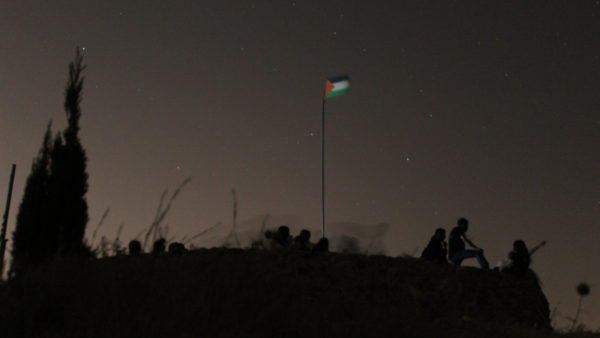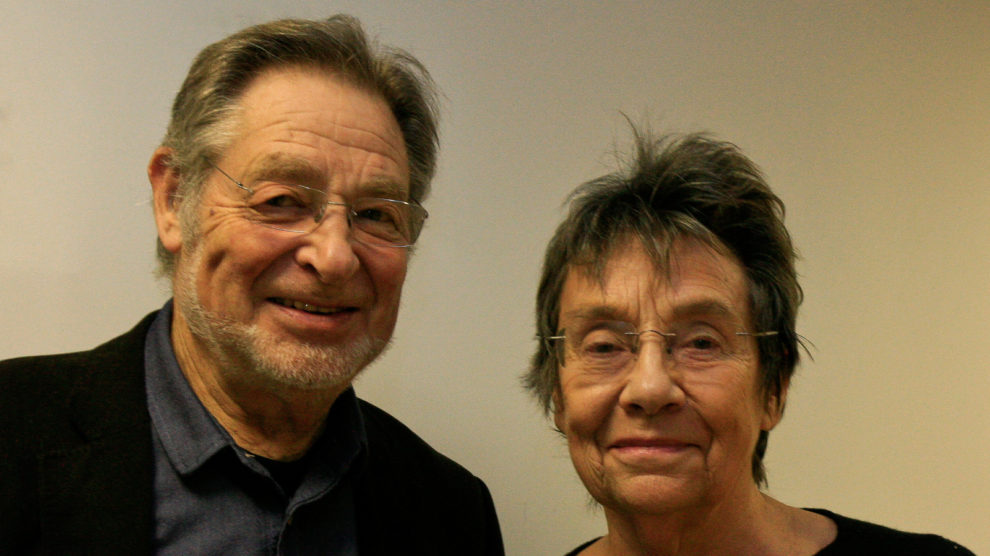Wonder and the Life of Palestinian Astronomy
By Jake Silver
Volume 23, number 1, Science Under Occupation

Carl Sagan said in 1991 that from an extraplanetary perspective, photography contains “no sign of humans.… We are too small and our statecraft is too feeble to be seen by a spacecraft.”1 In recent history, however, nations across the globe have been trying to change that. Extending their territorial might ever-closer to extraterrestrial life, various countries have thrust military and privately-owned technologies into Earth’s orbit, from spectral imaging apparatuses to cube satellites. The latter recently inspired American startups to invest in and market stratospheric imagery originally intended for military surveillance.2 The United States’s National Reconnaissance Office even chose to release a logo with their 2013 NROL-39 satellite depicting an octopus perched atop the earth, its tentacles hugging the globe’s surface. The caption reads: “Nothing is beyond our reach.”3
The cosmos has long provoked human wonder, whether it be about what exists out there, or how far the state’s tentacles might stretch. Recently, wonderings about both these mysteries have seized the public’s attention in Palestine. In a zone where the Israeli state and its mechanisms of surveillance and control extend into the most intimate domains of life, the expanses of the sky have sparked the creation of an entire world of astronomy, composed of constellations of NGOs, university majors, and community events. Here, wonder is not simply an innocent sensibility: it has raised important questions about how we think about human life amidst protracted conflict and colonization that can reach far into the sky. What might Palestinian wonder teach us about astronomy, political change, and our shared future?
Astronomy under empire
It may seem like a stretch for an American intelligence agency to claim that nothing is beyond its reach. Yet in occupied Palestine, the reaches of empire are well known and well documented—from checkpoints and walls and the fracturing of West Bank cities and villages, to the illegal arrest and detention of innocent Palestinians, to the ordinariness of Israeli incursions into Palestinian cities, where, according to the Oslo Accords, the Palestinian Authority is mandated to exercise full security control.4 On the ground in the West Bank, Palestinians experience these realities on a daily basis. When Palestinians, astronomers or otherwise, look up, it is this field of colonial control that they encounter.
Israel has explicitly made claims over vertical domains for security and military purposes. In 2000, during the second intifada, the state closed Qalandia Airport, the only airport serving Palestinian and Arab airlines.5 Israel also oversees the airspace above Palestinian-governed cities and territories, enabling it to fly drones and reconnaissance planes over Palestinian land.6 And Israeli war technologies like the Iron Dome, a defense system that employs predictive algorithms to intercept offensive rockets mid-flight, give them clear atmospheric military domination over Palestine.7 Through agreements with the United States, Israel has also blocked the public availability of higher-resolution satellite imagery above Israel/Palestine.8 An amendment to the US Land Remote Sensing Policy Act of 1992 limits declassified images of Israel/Palestine to a lower level of resolution, although this is not the case for European satellites.9 In my own ethnographic work with those who work for the Land Authority under the Palestinian Authority, I have found that when Palestinian municipalities buy satellite images from the Israeli state for city planning or defining land parcels (Israel possesses the most detailed aerial image files for use in GIS software), any areas that Israel wishes to censor from above—including, but not limited to, settlements—are awkwardly blurred, as if a godly paintbrush had smeared the Earth from above.
Palestinian astronomy, amateur and professional, peers toward this sky of oppression, toward the ways that Israel’s occupation has become volumetric in scope. Yet it also looks past the sky, into deep space. The wonder of the universe has seized Palestinian audiences, and the science has gone supernova over the past three years. The seeds began sprouting as Birzeit University in the early 2010s, where several interested students—the majority of whom were not majoring in physics, the larger scientific discipline that houses astronomy—came together to found the university’s astronomy club. With the support of the university’s past president, Dr. Hanna Nasir, and guidance from Professor Wafaa Khater, among others, the students attracted the attention of hundreds of college peers and the surrounding Ramallah community. The widespread enthusiasm catalyzed the construction of the university’s observatory, the first of its kind in the West Bank, which opened in 2015, as well as a curricular focus on astronomy in the university’s physics department. The public turned out in droves for the observatory’s first event, with over a thousand estimated to be in attendance.
Astronomy’s public presence has only grown since. The students most active in the club have taken to astronomy professionally, establishing groups and NGOs such as the Palestinian Astronomical Society and Nova. The former focuses on organizing astronomy camps, while the latter has partnered with eight Palestinian municipalities to conduct weekly observations in the summer and weekly lectures in the winter. The path to NGO recognition, however, has been circuitous: when Nova first applied for NGO status, the Palestinian Authority (PA) rejected their requests twice, contending that “there is no public need” for such a group, as one member told me. The PA’s rationale for rejection was never made known; like most decisions that are made through state channels in Israel or Palestine, it remains shrouded in bureaucratic secrecy. Yet the manifold activities that these groups have successfully organized completely disprove the PA’s contention that there is no public need.
When seeds of wonder sprout
Saad*, an astronomy organizer in Palestine, once said to me, “What’s out there? Isn’t that what drives every astronomer to astronomy?” Like in other places across the world, wonder is a key driver of astronomy’s popularity in Palestine. As Saad explained to me, the unknown attracts and seduces us. The potential to discover something unfamiliar or alien sparks our curiosity.
Saad’s fascination with the interstellar resonates with the thoughts of the most well known astronomers in the western world. Wonder is an oft-cited entry point for many into the space sciences: Neil deGrasse Tyson has said that his famous career in astrophysics began, quite simply, when he was “struck by the night sky.”10 From the United States to Palestine, human instinct drives astronomers to explore the mysteries of what may exist outside our own gravitational fields. Even NASA employees credit wonder with propelling interstellar research, projects, and missions forward (and upward).11 And for Adnan*, a co-founder of Nova, such wonder necessarily makes astronomy something worth sharing, worth exploring together. “Why not work to bring something you’re fascinated with to everyone else?” he told me while preparing telescopes for a neighborhood observation in the town of al-Bireh.
In November 2019, I was drinking tea with Saad, Adnan, and other astronomers in their new office in the center of Ramallah. “Who knew Nova would one day have an office!” I exclaimed. “We wanted to create Nova, so we did,” Saad responded. He followed by saying that Nova wants to share in simple scientific desires and passions with others across the world.
Humans share wonder, whether or not they are an occupied people. But in Palestine, this wonder takes on an additional valence. “Even if we want to just help everyone look at stars,” Saad told me, “it’s never just looking at stars. It’s always political.” Here, Saad was referencing the double bind of living under occupation: even the most banal things, like stargazing, can become political, sometimes even forms of resistance. Nova’s work becomes political, Saad explained, because every civil transformation in Palestine challenges Israel’s powerful hold on the population, a hold that has suppressed any civil, educational, and institutional growth in the West Bank and Gaza. “Science is everywhere,” he told me, because wonder entices people all across the world. “But here, it changes more than just the way people think. It changes the lay of the land.”
Astronomy beyond escapism
Historically, the wondrous night sky has inspired and helped state powers tighten their grasp on populations: British colonizers, for example, used nautical astronomy to navigate ocean currents during colonial missions.12 Astronomical wonder can also easily translate into state power when sky-gazing individuals end up working for national ministries, military or military-adjacent labs, or nationally backed wartime arsenals, as has been the case from the Cold War to the War on Terror.13 Astronomy, the moon, and the sky have offered colonial and imperial powers a particular set of tools to enact their future. Palestinians gather quite different elements from the sky to craft civil and scientific institutions, and their results can work to undo those very same systems of colonization. The sky offers us different paths, different possibilities. “We don’t live under the same sky as everyone else,” a Palestinian friend, Waleed*, once told me, “so you cannot study it like everyone else.”
From an outsider’s perspective, it is easy to overlook how astronomy is changing the landscape of scientific, educational, and professional possibilities in Palestine. As an anthropologist traveling around the world, I have heard countless responses to my work with Palestinian astronomers that trumpet a similar sentiment: that over there, in Palestine, astronomy is an escape, a getaway, a distraction. Saad, who lives in Jerusalem and encounters many Israelis and foreign visitors, told me: “It’s still taking time for people to realize that we’re an astronomical society, not an astronomical club…When I’ve spoken to astronomers in Europe, they don’t really understand what we do; they just think we’re a small group.”
To imagine astronomy in Palestine as nothing more than escapism ignores its vast social and political effects and limits our understanding of its potential for social good. Such logic bars Palestinians’ scientific, imaginative, and professional ambitions from transcending the confines of the occupation—even though that is exactly what Palestinian astronomy is doing. Despite the lack of official support, the popularity of astronomy in Palestine is skyrocketing: wonder is powering something transformative. At a cosmology lecture Nova organized over the summer of 2019, a high school student began her question by explaining how she hopes to pursue astronomy in university and, one day, professionally. She credited Nova and its events with making this science available to her.
The Palestinian Astronomical Society and Nova have planned camps, community observations, and lectures for both students and the public. This infrastructure is not only laying the foundation for educational trajectories that did not previously exist in Palestine, but is also creating scientific opportunities for Palestinians in new places and at new institutions. International scientists are leveraging Palestinian networks to extend research and professional opportunities to inquisitive Palestinians. Scientists for Palestine, an organization that arose out of European science networks, has created advanced physics schools for Palestinian students in the West Bank and Gaza, and has more recently coordinated conferences in Europe and the United States to support the development of the sciences in occupied Palestine.14 Thanks to the emergence of such groups, young astronomers have traveled to various countries in Europe, Africa, and North America, paths that may have been unavailable or unknown just five years ago. Scientists for Palestine’s second international conference in November 2018, for example, enabled professors from an-Najah and Birzeit Universities, including Dr. Khater, to offer lectures at Columbia University on both the difficulties and the successes of conducting physics research in the occupied territories.
Where might wonder lead?
What might life in Palestine look and feel like without Israel’s occupation? Will there be a return to historic Palestine? A sovereign Palestinian state? Something else? Palestinians wonder about these questions all the time, just as many Palestinians are increasingly wondering about the sky. And wonder, perhaps, offers something transformative. It can create new institutions and alter the ground (and the atmospheres) in which Israel’s occupation exerts its force.
But wonder is not innocent. Wonder can also draw colonial powers to the sky for scientific and, ultimately, territorial ends, as colonial England did and as Israel and other imperial powers continue to do today. The wondrous expanses of the sky and outer space can inspire contradictory forces: some in the name of control and some in the name of freedom or liberation. By creating new possibilities in a place so often discussed in terms of conflict, destruction, and oppression, astronomy in Palestine may offer us a new way to think about wonder and science along a vertical axis. Perhaps from this perspective, wonder can gain a new life, one whereby the interstellar becomes an extension of humanity rather than an extension of empire.
*Names have been changed
About the Author
Jake Silver is a cultural anthropologist completing his PhD at Duke University. His research concerns how atmospheric and interstellar realms are a part of colonial and anticolonial struggle in Israel/Palestine; in particular, how these volumetric, seemingly faraway fields come to condition the everyday ways that we grasp the forms and reaches of empire as well as the political possibilities (on our planet and beyond) that can take shape in their wake.
References
- Carl Sagan, Pale Blue Dot: A Vision of the Human Future in Space (New York: Random House, 1994), 11.
- Cade Metz, “‘Businesses Will Not Be Able to Hide’: Spy Satellites May Give Edge from Above,” The New York Times January 24, 2019.
- Paul Szoldra, “US Spy Agency Boasts ‘Nothing Is Beyond Our Reach’ with New Logo,” Business Insider December 7, 2018.
- Lisa Monaghan and Grazia Careccia, The Annexation Wall and its Associated Regime: The Wall Campaign: Ten Years Too Long (Ramallah: al-Haq, 2012); Adam Aloni and Shuli Wilkansky, Exploit and Expel: The Israeli Practice of Taking Over Rural Palestinian Land (Jerusalem: B’Tselem, 2016); Addameer, Administrative Detention in the Occupied Palestinian Territory: A Legal Analysis Report, Fourth Edition (Ramallah: Addameer Prisoner Support and Human Rights Association, 2016); Palestinian Center for Human Rights, Annual Report 2018 (Gaza City: Palestinian Center for Human Rights, 2018); Human Rights Watch, “Born Without Civil Rights: Israel’s Use of Draconian Military Orders to Repress Palestinians in the West Bank,” December 17, 2019.
- Marian Houk, “Atarot and the Fate of the Jerusalem Airport,” Jerusalem Quarterly 35 (2008): 64–75.
- Alison J. Williams, “A Crisis in Aerial Sovereignty? Considering the Implications of Recent Military Violations of National Airspace,” Area 42, no. 1 (2010): 51–59.
- “U.S.-Israel Strategic Cooperation: Iron Dome Missile Defense System,” Jewish Virtual Library.
- Hamed Aleaziz, “Why Google Earth Can’t Show You Israel,” Mother Jones, June 10, 2011.
- Eyal Weizman, Forensic Architecture: Violence at the Threshold of Detectability (Brooklyn: Zone Books, 2017), 29.
- Dan Schawbel, “Neil deGrasse Tyson: How He Became America’s Top Astrophysicist,” Forbes, May 19, 2017.
- Maggie Masetti, “‘Always Keep Your Sense of Wonder,’” NASA, February 16, 2011.
- Wayne Orchiston, “From the South Seas to the Sun: The Astronomy of Cook’s Voyages,” in Science and Exploration in the Pacific: European Voyages to the Southern Oceans in the Eighteenth Century, edited by Margarette Lincoln (Woodbridge: Boydell & Brewer, 1998).
- Juan C. Lucena, Defending the Nation: U.S. Policymaking to Create Scientists and Engineers from Sputnik to the “War Against Terrorism” (Lanham, MD: University of America Press, 2005).
- See this issue’s report on the 2020 Scientists for Palestine meeting by Hubert Murray.





